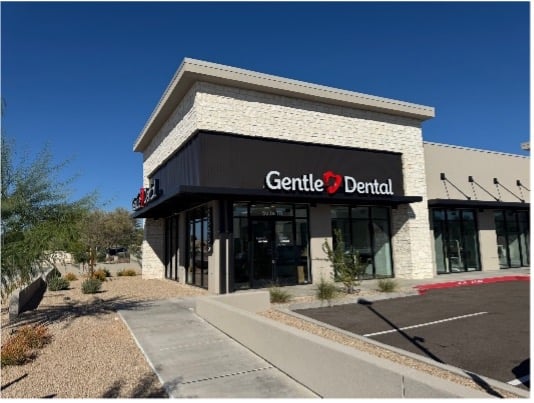Dental Veneers vs Dental Bonding

We’re proud to offer dental bonding and veneers at Gentle Dental, two fantastic options for enhancing your smile. To help you make the best choice, we’ve outlined the key differences between these treatments so you can confidently invest in your smile transformation.
Key Differences Between Dental Bonding and Veneers
Both dental bonding and veneers address concerns like discoloration, chips, or gaps, but they differ in materials, application, and longevity. Before settling on a treatment option, its important to understand the different benefits that these procedures provide.
What is Dental Bonding?
Dental bonding is a minimally invasive cosmetic dental procedure where a tooth-colored resin is applied and sculpted to the tooth's surface to improve its shape, size, or color. This treatment is great for minor imperfections, such as small chips or gaps, and can usually be completed in a single visit. While dental bonding is affordable and effective, it is less durable than veneers and may require touch-ups over time.
What are Dental Veneers?
Veneers are thin, custom-made shells of porcelain or composite material designed to cover the front surface of teeth for a flawless appearance. This procedure involves removing a small amount of enamel to ensure a precise fit and natural look. Veneers are a longer-term solution for significant cosmetic concerns, offering superior durability, stain resistance, and a more dramatic transformation compared to bonding.
Questions to Consider When Thinking About Dental Bonding vs Veneers
Are you unsure which option is right for you? Consider these important questions to help you understand your smile goals and the level of investment you are interested in making.
How Much Do You Want to Change the Appearance of Your Teeth?
When deciding between dental bonding and veneers, the type of transformation you seek is crucial. Dental bonding is best for minor imperfections, such as small chips, slight discoloration, or minor gaps, offering a subtle improvement. Veneers, particularly porcelain veneers, provide a more comprehensive makeover, addressing larger cosmetic concerns like significant discoloration, uneven teeth, or worn enamel. If you’re looking for a dramatic and long-lasting enhancement, veneers may be the better choice.
How Long Do You Want Your Dental Work to Last?
The longevity of your dental work depends on the material and procedure. Dental bonding typically lasts 3–10 years but may require periodic touch-ups due to its susceptibility to chipping or staining. Composite veneers have a similar lifespan of 5–7 years, while porcelain veneers can last 10–15 years or more with proper care. If durability and low maintenance are priorities, porcelain veneers are a worthwhile investment, while bonding or composite veneers may be suitable for shorter-term solutions.
What Is Your Budget for Dental Work?
Price of Dental Veneers
Your budget will play a significant role in choosing between bonding and veneers, but it’s important to consider the value each option provides over time. Composite veneers, priced between $250 and $1,500 per tooth, offer a middle ground for those seeking a noticeable improvement at a moderate cost. Porcelain veneers, while ranging from $900 to $2,500 per tooth, represent a long-term investment in your smile. Their superior quality, durability, and stain resistance mean fewer replacements and touch-ups, making them an ideal choice for patients looking for a lasting and relatively low-maintenance solution.
Price of Dental Bonding
Dental bonding is generally the most cost-effective option for minor adjustments. With costs ranging from $100 to $600 per tooth, dental bonding offers a reliable and more affordable solution for patients seeking quick improvements. However, it’s important to note that bonding may require more frequent maintenance compared to veneers. The resin material used in bonding is more prone to chipping and staining, so regular dental visits and occasional touch-ups may be necessary to maintain its appearance over time.
How Much Time Are You Able to Invest?
The time commitment for dental procedures varies by treatment. Dental bonding is the quickest initially, often completed in a single visit, making it ideal for patients with tight schedules. Composite veneers can take 1–2 visits, depending on the extent of the work. Porcelain veneers require the most time, typically involving 2–3 appointments over several weeks to allow for custom fabrication and precise fitting. If time is a factor, bonding offers convenience, while veneers demand more upfront investment for lasting results.
Timeline for Dental Bonding
- Initial Consultation (1 Visit): During the first visit, your dentist will discuss your cosmetic goals, evaluate your teeth, and determine if dental bonding is the right treatment option for you.
- Bonding Procedure (1 Visit): Your dentist will lightly etch the surface of your teeth to prepare them, apply a tooth-colored resin, sculpt it to the desired shape, and harden it with a special light. The entire procedure typically takes 30–60 minutes per tooth, and results are immediate.
- Post-Procedure Care (Same Day): After the procedure, you can return to your normal activities right away.
- Follow-Up and Maintenance (Ongoing): Regular dental checkups every six months are important to monitor the condition of your bonded teeth. Touch-ups or repairs may be needed every 3–10 years.
Timeline for Dental Veneers
- Initial Consultation (1 Visit): During the first dental visit, your dentist will discuss your cosmetic goals and evaluate your teeth to determine if veneers are the right treatment option for you. They will explain the differences between composite and porcelain veneers and help you choose the best option based on your needs, preferences, and budget.
- Tooth Preparation (1 Visit): At the second visit, the dentist will prepare your teeth by removing a small amount of enamel to ensure the veneers fit properly and look natural. For porcelain veneers, impressions or digital scans of your teeth will be taken to create custom veneers. Temporary veneers may be placed to protect your teeth while the permanent ones are being fabricated.
- Fabrication Period: If you choose porcelain veneers, a dental lab will create your custom veneers, which typically takes 1–2 weeks. Composite veneers, on the other hand, can often be created and applied in a single visit.
- Veneer Placement (1 Visit): At your next appointment, the dentist will bond the veneers to your teeth using a strong adhesive.
- Post-Procedure Care (Same Day): After placement, you can resume normal activities, but your dentist may recommend avoiding staining foods and beverages for the first few days. Maintaining proper oral hygiene and regular dental checkups will help prolong the life of your veneers.
- Follow-Up and Maintenance (Ongoing): With proper care, composite veneers can last 5–7 years, while porcelain veneers typically last 10–15 years or more. Routine dental visits and good oral hygiene are essential to keeping your veneers in excellent condition.
Enhance Your Smile with Expert Solutions at Gentle Dental
Looking to upgrade your smile? Schedule a consultation with our expert team at Gentle Dental! We’ll guide you through all your options for dental bonding and veneers and help you find the perfect fit for your smile goals.


.jpeg)